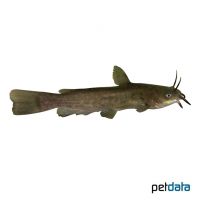Brown Bullhead (Ameiurus nebulosus)
| Brown Bullhead Ameiurus nebulosus | |
|---|---|
| Name | Brown Bullhead |
| Name Lat. | Ameiurus nebulosus |
| Synonym | Pimelodus nebulosus |
| Family | North American Freshwater Catfishes |
| Family lat. | Ictaluridae |
| Order | Catfishes |
| Order lat. | Siluriformes |
| Origin | North America |
| Habitat | Rivers, lakes |
| Diet | Omnivore |
| pH | 6.5-7.5 |
| Behavior | Nocturnal, predatory |
| Keeping | Individual, pair |
| Care Level | Moderate |
| Reproduction | Substrate spawner |
| Breeding | Moderately difficult |
| Life Span | 6-8 years |
| Protection | No |
| Metric Units | |
| Size | 25 cm |
| Temperature | 4-30 °C |
| Hardness | 5-15 °dH |
| Aquarium | Ponds |
| US Units | |
| Size | 10" |
| Temperature | 39-86 °F |
| Hardness | 89-267 ppm |
| Aquarium | Ponds |
Distribution and habitat
The nocturnal Brown Catfish are widely distributed in central and eastern North America, from southern Canada to Florida. These adaptable fish live mostly hidden during the day in large, slow-moving or stagnant waters. They have been introduced to many countries in Europe and Asia
Maintenance
The pond should be furnished with pond, floating and oxygenating underwater plants (milfoil, waterweed, hornwort, etc.), large river pebbles and numerous hiding places, as well as a soft substrate of round-grained gravel and sand suitable for burrowing, and offer free swimming space.
No ammonia, ammonium or nitrite must be detectable in the water, and the nitrate value must not exceed 100 mg/l. To ensure the water quality and oxygen content, a filter adapted to the water volume is necessary.
Diet
They are greedy and voracious predators that feed on insect larvae, snails, earthworms, crabs, fish and frogs according to their size, but also eat plant material and algae. The food supply consists of a sinking dry food for pond fish (granules, pellets), supplemented with insect larvae, worms, smelts, etc. (live or frozen).
Feed only as much as will be eaten within a few minutes. A regular and varied diet promotes health and increases resistance
Behaviour and compatibility
Brown catfish are usually peaceful, but aggressively defend their territory during spawning season. Socialization with defensible fish, such as sunfish or large carp fish is possible. Frogs, crayfish and too small fish are considered food
In principle, only mutually compatible fish species with similar demands on water quality and water temperature may be socialized.
Reproduction and breeding
No external distinguishing characteristics are known. At spawning time, the females appear somewhat rounder.
In their native habitat they spawn between March and May at a water temperature of 18-20 °C. The female lays up to 500 eggs in a self-made shallow bottom pit near the shore. The female fans the eggs while the male guards the territory. After 5-8 days the larvae hatch, which are guarded by the parents for another 10 days before the brood care ends.
Important
The brown catfish is not a native species and therefore special care must be taken to prevent it from entering the wild (fauna adulteration!), as it can cause great harm to native flora and fauna. They are hardy and have low water quality requirements. The dorsal and pectoral fins have strong spiny rays, with venom glands in the skin. Care should be taken when catching them, as the spiny rays can cause painful stinging injuries.
If they are overwintered in the pond, ensure sufficient depth and oxygen supply (filter, oxygen dispenser, ice free holder).
At temperatures below 8-10 °C, the metabolism of the fish slows down and no more food is accepted; feeding must be stopped accordingly. If the temperature drops further, they hibernate near the bottom. In spring, with rising temperatures, feeding can slowly be resumed. Feeding may also be necessary during prolonged warm periods in winter.
The well-being of the fish should be monitored regularly. A regular partial water change, according to the pond size is recommended, even if the pollutant load has not yet reached the upper limit. Sudden changes in water quality should be avoided. Newly introduced fish must be accustomed to the water slowly
Further literature can be found in your pet store.
References
Text: Werner Winter; Image: petdata
Source: BMELV (1998): Tierschutzgutachten - Haltung von Zierfischen (Süßwasser); RIEHL & BAENSCH (2006): Aquarien Atlas Bd. 3, Mergus Verlag; ENGELMANN (2005): Zootierhaltung - Tiere in menschlicher Obhut: Fische, Verlag Harri Deutsch
- Gemäß § 21 Abs. 5 Tierschutzgesetz idgF
